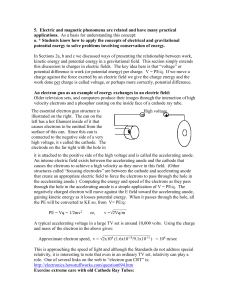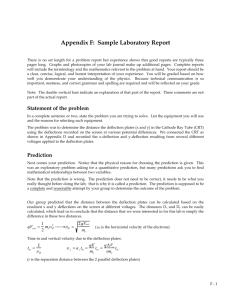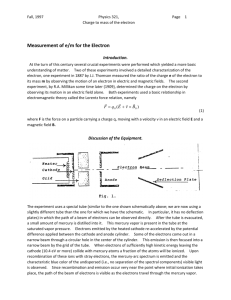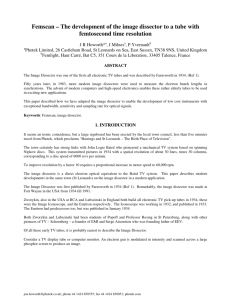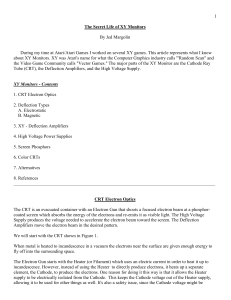LAB 4
advertisement
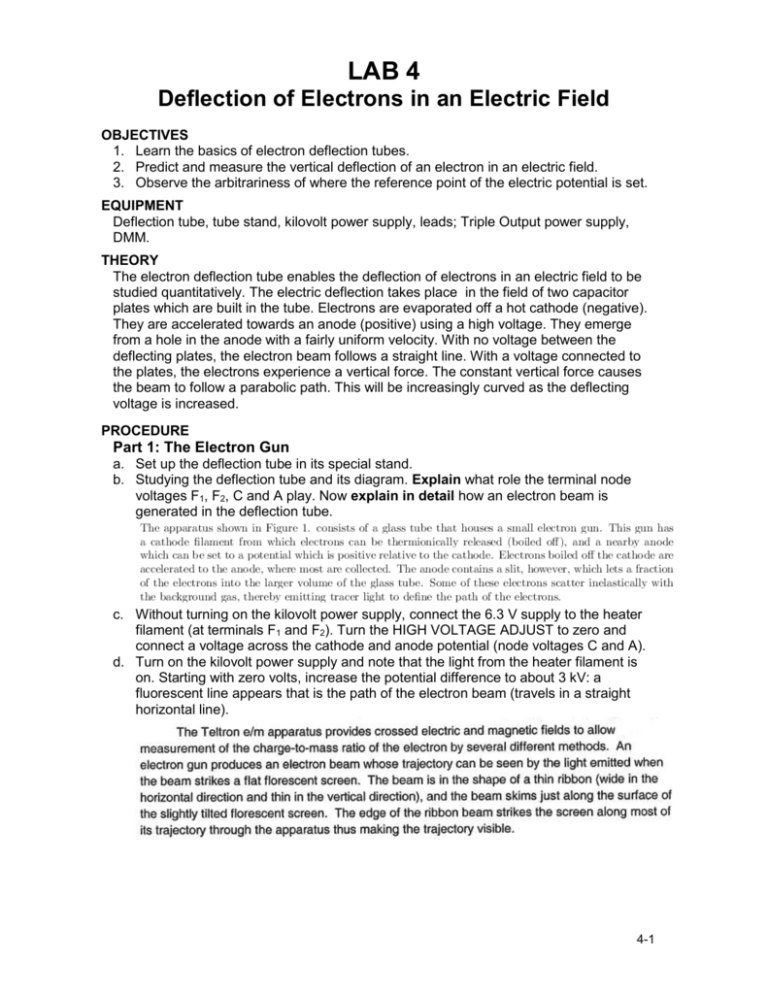
LAB 4 Deflection of Electrons in an Electric Field OBJECTIVES 1. Learn the basics of electron deflection tubes. 2. Predict and measure the vertical deflection of an electron in an electric field. 3. Observe the arbitrariness of where the reference point of the electric potential is set. EQUIPMENT Deflection tube, tube stand, kilovolt power supply, leads; Triple Output power supply, DMM. THEORY The electron deflection tube enables the deflection of electrons in an electric field to be studied quantitatively. The electric deflection takes place in the field of two capacitor plates which are built in the tube. Electrons are evaporated off a hot cathode (negative). They are accelerated towards an anode (positive) using a high voltage. They emerge from a hole in the anode with a fairly uniform velocity. With no voltage between the deflecting plates, the electron beam follows a straight line. With a voltage connected to the plates, the electrons experience a vertical force. The constant vertical force causes the beam to follow a parabolic path. This will be increasingly curved as the deflecting voltage is increased. PROCEDURE Part 1: The Electron Gun a. Set up the deflection tube in its special stand. b. Studying the deflection tube and its diagram. Explain what role the terminal node voltages F1, F2, C and A play. Now explain in detail how an electron beam is generated in the deflection tube. c. Without turning on the kilovolt power supply, connect the 6.3 V supply to the heater filament (at terminals F1 and F2). Turn the HIGH VOLTAGE ADJUST to zero and connect a voltage across the cathode and anode potential (node voltages C and A). d. Turn on the kilovolt power supply and note that the light from the heater filament is on. Starting with zero volts, increase the potential difference to about 3 kV: a fluorescent line appears that is the path of the electron beam (travels in a straight horizontal line). 4-1 Warning: after you have completed your observations and without turning off the power supply, turn the HIGH VOLTAGE ADJUST to zero. The light from the heater filament will stay on. Part 2: Deflection of Electrons in an Electric field Predict the Deflection trajectory a. Use Newton’s 2nd law and the projectile equations in two-dimensions to predict the vertical deflection y of an electric charge moving through an assumed uniform E-field as a function of horizontal distance x, charge e, electric field E, velocity v, and mass m. b. Rewrite this equation using the following two steps. Use conservation of energy to replace the velocity of the electron beam with the accelerating potential difference Vanode. Replace the E-field function between the parallel plates with the potential difference Vplates across the parallel plates. The vertical deflection equation as a function of position x, plate separation d, potential differences Vanode and Vplates is y thy 3Vplates 16Vanode d x2 Important Note: The electric field of two infinite plates is related to the voltage across and the distance between the plates: E = Vplates/d. However, these plates are finite and the electric field is smaller. This can be taken into account in the experiment by a correction factor such that Eexpt = 0.75Vplates/d. 4-2 Measuring the beam deflection & trajectory for Vplates=Vanode/2 c. Connect the full kilovolt power supply across the deflection plates and connect the voltage across the accelerating anode to be half of the voltage across the deflection plates (Vplates=Vanode/2). Starting from 0 V, increase the voltage (Vplates) to 5 kV in 0.5 kV increments. You should now see a curved trajectory due to the vertical electric force applied to the electron beam. CAUTION: do not increase the voltage greater than 5 kV. d. Measure the horizontal and vertical components (xexpt, yexpt) of the trajectory for every 1-cm of horizontal distance. Recorded your data into a table. e. To analyze your data Compare theoretical (ythy) and experimental vertical deflections (yexpt) for every 1cm of horizontal distance using a percentage to compare; how do they compare? Plot ythy and yexpt on a single graph. After you have completed your measurements and without turning off the power supply, turn the HIGH VOLTAGE ADJUST to zero. The light from the heater filament will stay on. Measuring the beam deflection & trajectory for Vanode=Vplates f. Repeat parts (2c, 2d, 2e) for Vplates = Vanode. Questions to answer Explain how the trajectory of the electronic beam will change if the power supply voltage is increased from 0 kV to 5 kV in 0.5 kV increments? Now actually change it to see what happens. Explain using physics ideas the behavior of the beam? Is the trajectory consistent with the beam being made of negatively charged particles? Is the trajectory consistent with the beam being made of massive or massless particles? Can we deduce that the beam is made of particles with some mass and a negative charge? Explain your reasoning. What physical evidence is there that all of the particles in the beam are the same type of particles? Hint: look at it mathematically The parallel plates are not infinite but finite in size. How does your data show these limitations in your results? Part 3: Independent Ground-Reference (“Floating”) According to the definition of electric potential, only differences can be measured, and therefore, where the reference point is defined is arbitrary. To show this arbitrariness in the electric potential function, we will configure a Triple Output Power Supply for independent “floating” or arbitrary ground. The Triple Output Power Supply is a variable-voltage, triple-output DC voltage source used to provide DC power to electrical circuits. There are two variable voltage sources (A and B) and a fixed 5V voltage source (with 4A maximum output). When in INDEPENDENT mode, variable supplies are independently controlled by front panel voltage and current controls. a. Measure the voltage across the green (earth) ground terminal and the negative terminals (or ground) associated with each voltage source (A, B and Fixed). Note that these ground terminals are not zero. One can set these negative (or positive) terminals to zero by strapping a lead between the earth ground and the particular negative (or positive) terminal or each output terminal can be left floating with respect to the ground. A power supply is considered to be floating if no part of the output of the power supply is connected to earth ground. b. Use a Triple Output Power Supply (in independent mode) with a breadboard to configure the power supply for independent floating, using the following procedure: 4-3 With the Triple Output power supply on and the outputs disconnected from loads, set the A and B VOLTAGE controls to the values needed. Turn power to OFF, and connect the load(s). Turn power to ON, and readjust voltages if necessary with a DMM. c. Using the diagram below as a guide, strap a lead between the positive terminal of B to the negative terminal of A. Setup the three following potential differences such that the difference in electrical potential is always 10V: (0V, 10V), (-10V, 0V), and (-5V, +5V). Is the potential difference differences measured by the DMM the same? Why is the reference potential arbitrary? Explain your reasoning. Have the instructor or LIA check you off here. 4-4

